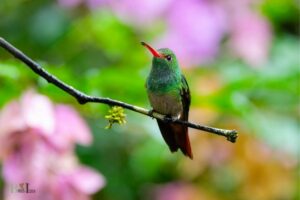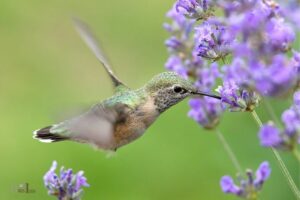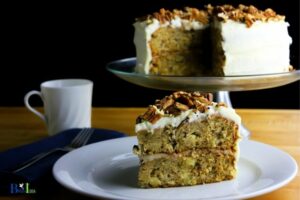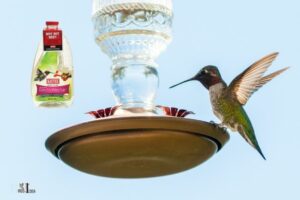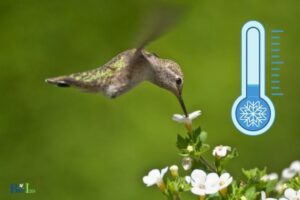How to Make a Hummingbird House: Step By Step!
To make a hummingbird house, you need to create a small, cozy nesting platform that is secure, weather-resistant, and tailored to the nesting habits of hummingbirds.
Hummingbirds are not like other birds that nest in traditional birdhouses with a hole and a cavity inside. Instead, they prefer to build their nests on small, flat surfaces with some overhead cover to protect them from the elements and predators.
By providing a suitable nesting platform, you can encourage these delightful birds to take up residence in your garden.
When constructing a hummingbird house, it’s essential to consider their unique nesting habits. Start by building a small and flat nesting platform that measures around 3×3 inches in size. Use weather-resistant materials like wood or cork to ensure the platform’s durability.
To provide additional protection, add a roof to the platform, which can be made from bark, leaves, or other natural materials. Hang your finished hummingbird house 10-15 feet off the ground in a shady, sheltered location, such as under a tree branch or near dense foliage.
This will provide the hummingbirds with a safe and comfortable place to build their nest and raise their young.
8 Step-by-step Guide to Making a Hummingbird House
| Step | Materials Needed | Instructions |
| 1 | Wood, Saw | Cut a piece of wood into a base that is approximately 6×6 inches. |
| 2 | Wood, Saw, Nails | Cut two pieces of wood at a 15-degree angle to create the side walls of the house. Attach the walls to the base with nails. |
| 3 | Wood, Saw, Nails | Cut two more pieces of wood to create the front and back walls (with a small entrance hole in the front wall). Attach these walls to the base and side walls with nails. |
| 4 | Wood, Saw, Nails | Cut a piece of wood to create the roof of the house. Make sure it is large enough to cover the entire house and create an overhang above the entrance hole. Attach the roof with nails. |
| 5 | Sandpaper | Sand all edges and surfaces of the hummingbird house to remove any rough spots or splinters. |
| 6 | Paint, Brush | Paint the hummingbird house with non-toxic, weather-resistant paint to protect it from the elements and make it more attractive to hummingbirds. |
| 7 | Eye Hook, Drill | Attach an eye hook to the top of the hummingbird house, so it can be hung from a branch or hook. |
| 8 | String, Branch | Hang the finished hummingbird house from a branch or hook in an area that is easily visible and accessible to hummingbirds. |
Key Takeaway
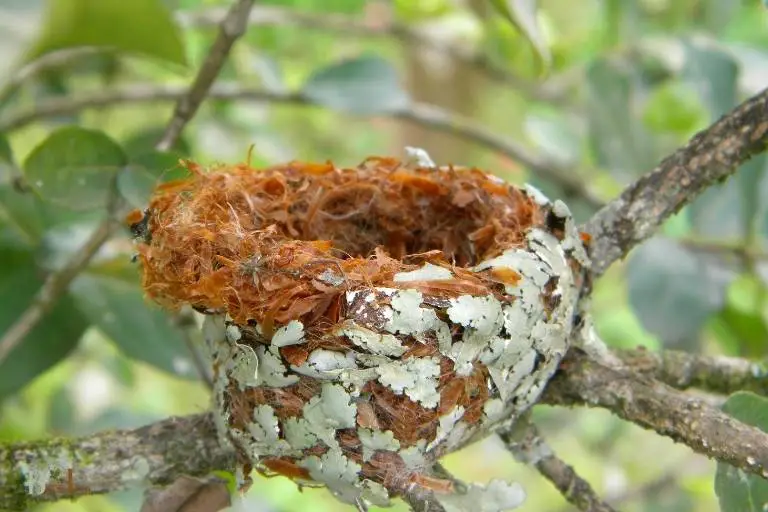
Five Facts About: Hummingbird Houses
Understanding The Basics Of A Hummingbird House Design
What Is A Hummingbird House?
Hummingbird houses are small structures designed to provide the perfect habitat for hummingbirds. They are intended to give these beautiful birds a secure place to build their nests and rest.
These houses usually have small entrances and are typically made of wood or other natural materials.
Why Do Hummingbirds Need Houses?
Hummingbirds need houses because they are tiny birds that love to build their nests in sheltered places.
A hummingbird house provides protection from predators, harsh weather conditions and gives them a safe place to lay their eggs and take care of their chicks.
It also gives birdwatchers the opportunity to observe these amazing little birds up close.
What Are The Essential Components Of A Hummingbird House Design?
A properly designed hummingbird house should have the following components:
- Entrance hole: The entrance hole size should be about 1.5 inches in diameter. This size provides a perfect fit for hummingbirds while keeping other birds and predators out.
- Nesting compartment: Inside the hummingbird house, there should be enough space for the birds to build their nest. The compartment should have a rough surface to help the birds anchor their nests properly.
- Ventilation: The birdhouse should have proper ventilation to ensure that the air inside circulates and prevents the buildup of hot air. Without proper ventilation, the birds may overheat and abandon the nest.
- Drainage: The hummingbird house should have drainage holes at the bottom to prevent waterlogging inside the nest.
- Roofs and overhangs: It’s best to have a sloping roof with an overhang to protect the birds from the rain. Hummingbird houses should also have perches outside, giving the birds a place to rest.
When building a hummingbird house, ensure that you use natural materials like wood, bamboo, or gourds. These natural materials provide the birds with a familiar nesting habitat and give them a sense of security.
Overall, building a hummingbird house is a fun activity and a great way to help these incredible birds thrive. So why not put your diy skills to the test and build a hummingbird house today?
Step-By-Step Guide On How To Make A Hummingbird House
Making a hummingbird house is easy and a great way to welcome these delightful creatures into your garden. In this step-by-step guide, we will take you through the process of making a hummingbird house, from choosing the right materials to painting and staining.
Follow the instructions below to make your own hummingbird house.
Choosing The Right Materials
Before you start making your hummingbird house, you need to choose the right materials.
Here are some essential materials you will need:
- Cedarwood: Cedarwood is the perfect material for making a hummingbird house as it is lightweight and weather-resistant.
- Nails and screws: Use nails and screws to assemble the pieces of your hummingbird house
- Perches: Hummingbirds need perches to stand on, so make sure you have some ready before you start assembling the pieces.
Measuring And Cutting The Wood
Once you have all the materials, it’s time to start measuring and cutting the wood.
Here are the steps to follow:
- Use a jigsaw or handsaw to make a 1 ½” entrance hole in the front piece.
- Cut two pieces of wood for the roof, each measuring 6” x 9”.
- Cut two pieces of wood for the perches, each measuring 1” x 6”.
Assembling The Pieces
Now that you have cut the wood into the correct sizes, it’s time to assemble the pieces.
Follow these steps:
- Attach the back piece to the sides using nails or screws.
- Attach the front piece to the sides using nails or screws.
- Attach the roof pieces to the top of the house using nails or screws.
Adding A Roof And Perches
Now that you have assembled the house, it’s time to add the roof and perches.
Follow these steps:
- Attach the remaining ends of the perches to the sides of the house, just below the entrance hole.
- Cut a piece of cedarwood to make a hinge and attach it to the roof pieces using screws.
- Attach the roof to the top of the house using the hinge.
- Your hummingbird house is now complete and ready to be placed in your garden.
Painting Or Staining The House
If you want your hummingbird house to look more attractive, you can paint or stain it.
Follow these steps:
- Sand the wood to create a smooth surface.
- Apply a coat of primer to the wood and let it dry.
- Apply a coat of paint or stain and let it dry.
- Apply a second coat if necessary.
Congratulations! You have successfully made a hummingbird house. Place it in your garden and watch as these delightful little birds come to visit.
Tips And Tricks For Making A Hummingbird House
Creating a hummingbird house is an excellent way to make your garden or backyard more inviting, and it provides a fun bird-watching experience. However, there are a few things to consider before building your hummingbird house.
Below are some tips and tricks to ensure that your hummingbird house is safe, attractive, and easy to maintain.
How To Ensure The House Is Safe For Hummingbirds
Hummingbirds are small and delicate birds, so their safety and comfort should be your top priority.
Here are some tips to ensure that the hummingbird house you make is a safe and cozy place for them:
- Choose a place to install your hummingbird house that is well protected from wind, rain, and direct sunlight.
- Make sure the size of the entrance is suitable for the birds you’re aiming to attract.
- Use natural materials to ensure the house is non-toxic and safe for birds.
- Ensure the house is well-balanced and sturdy enough to withstand storms and is resistant to predators like cats and squirrels.
- Avoid using harmful chemicals to clean or treat the hummingbird house.
How To Attract Hummingbirds To The House
Hummingbirds are fascinating birds to watch. Therefore, it’s essential to attract them to your hummingbird house to increase the chances of bird-watching.
Here are some tips to attract hummingbirds to your house:
- Install your hummingbird house near flowers, trees, and bushes that hummingbirds find attractive.
- Offer a sugar-water solution to supplement their natural food source.
- Hang wind chimes or wind spinners to add movement to the area, which attracts hummingbirds.
- Offer greenery around the entrance to the house to make it more attractive and inviting.
- Play a recording of hummingbirds to help attract their attention.
How To Maintain And Clean The House
Like any other structure, hummingbird houses require periodic cleaning and maintenance to ensure they’re clean, functional, and safe for the birds.
Below are some tips to make it easier to clean and maintain your hummingbird house:
- Use natural materials like pine needles or grass as the house’s base to make cleaning easier.
- Clean the house regularly with hot water and no chemicals. You can use a small brush to remove dirt and grime
- Ensure the house is well-ventilated to keep it dry and clean.
- Replace any damaged or worn materials regularly.
- Check for pests like spiders or bees to avoid infestation.
Common Mistakes To Avoid
When making a hummingbird house, it’s essential to avoid common mistakes that may harm the birds or render the house ineffective.
Here are some of the most common mistakes to avoid:
- Using toxic materials to make the house may harm the birds.
- Poor installation that doesn’t offer enough protection from harsh weather or predators.
- Choosing the wrong size or configuration may be uninviting or unsuitable for hummingbirds.
- Poor maintenance may cause the house to be less functional, unclean, and unsafe.
- Not providing enough food and water sources may decrease the chances of hummingbirds visiting the house.
A hummingbird house’s success is dependent on several factors, like ensuring the house is safe, attractive, and easy to maintain.
By following the tips and tricks presented in this post, you can create a hummingbird house that is perfect for the birds, enhances their natural habitat, and provides excellent bird-watching experiences for you and your family.
Decorating And Enhancing Your Hummingbird House
How To Add Decorative Accents
Decorating a hummingbird house can make it more attractive and eye-catching.
Here are some ideas to help you add decorative accents to your hummingbird house:
- Paint the house – give the house a bright and cheerful coat of paint to make it more visually appealing to hummingbirds.
- Add flowers – attach silk or dried flowers around the outside of your hummingbird house to create a more natural and authentic look.
- Decorative stones – use colorful stones to embellish your hummingbird house and blend it with the surrounding garden.
- Use stencils – create unique patterns on your hummingbird house using stencils.
Ideas For Personalizing Your Hummingbird House
Personalizing your hummingbird house can make it stand out from other birdhouses in the garden.
Here are a few ways to make your hummingbird house more personalized:
- Paint it with your favorite colors – use your favorite colors to paint the house to make it more personalized.
- Use a unique roof material – try using different materials like corrugated metal or even real wood shingles to create a unique look for your roof.
- Hummingbird name sign – create a small sign with your hummingbird’s name on it and attach it to the house to add a personal touch.
- Hang a small wind chime – add a small wind chime to the hummingbird house to create a gentle and pleasing sound.
Enhancing The Garden Area Around The House To Attract Hummingbirds
Creating an attractive garden area around your hummingbird house can help you attract more hummingbirds.
Here are some tips to enhance the garden area:
- Add flowering plants – hummingbirds love flowers. Make sure to plant nectar-rich flowers that bloom all season near your hummingbird house.
- Add a hummingbird feeder – add a feeder to the garden area around your hummingbird house to ensure the hummingbirds always have a ready supply of nectar.
- Create a water source – hummingbirds need to drink water frequently, so add a water source like a small bird bath or a fountain to the garden area around your hummingbird house.
- Keep it clean – hummingbirds are attracted to clean environments, so make sure to keep the area around your hummingbird house clean and free of debris.
Follow these simple tips, and you’ll soon have a beautifully decorated hummingbird house that will attract many hummingbirds to your garden.
FAQ Of How To Make A Hummingbird House
What Is A Hummingbird House?
What Materials Are Needed To Make A Hummingbird House?
Where Should I Place My Hummingbird House?
How Do I Maintain My Hummingbird House?
How Long Does It Take For Hummingbirds To Nest In The House?
Conclusion
Attracting hummingbirds to your yard is a real joy. But giving them a cozy place to spend their nights is even better. Making your own hummingbird house is a great diy project that you can do with your family or on your own.
From choosing the right wood to building the perfect house, this guide covers every step of the process. Be sure to place your hummingbird house in a spot that is sheltered from the wind and predators.
Make sure to clean and disinfect the house every couple of weeks to keep your feathered friends healthy and happy.
Creating a hummingbird house is not just great for the birds, it’s also rewarding for you. You get the satisfaction of creating something beautiful, while providing a safe haven for one of nature’s most fascinating creatures. Enjoy the process and happy bird watching.


